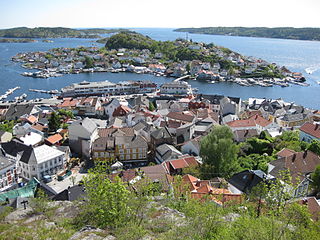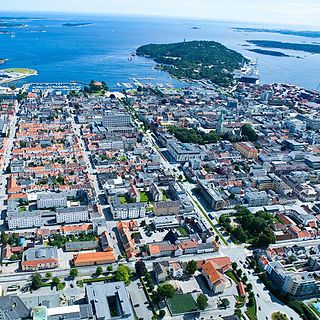
Ringsaker (help·info) is a municipality in Hedmark county, Norway. It is part of the traditional region of Hedmarken. The administrative centre of the municipality is the city of Brumunddal.
Nidaros, Niðarós or Niðaróss was the medieval name of Trondheim when it was the capital of Norway's first Christian kings. It was named for its position at the mouth of the River Nid.

Bærums Verk is a village in Bærum in Akershus, Norway, with a population of about 8000. It is located on both sides of the river Lomma.
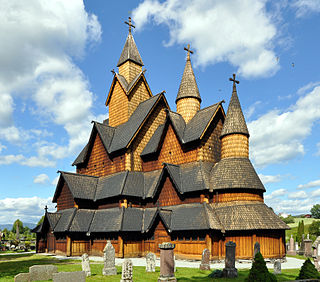
A stave church is a medieval wooden Christian church building once common in north-western Europe. The name derives from the building's structure of post and lintel construction, a type of timber framing where the load-bearing ore-pine posts are called stafr in Old Norse. Two related church building types also named for their structural elements, the post church and palisade church, are often called 'stave churches'.

Borgund Stave Church is a stave church located in the village of Borgund in the municipality of Lærdal in Sogn og Fjordane county, Norway. It is classified as a triple nave stave church of the Sogn-type. The church is part of the Borgund parish in the Indre Sogn deanery in the Diocese of Bjørgvin. No longer regularly used for church functions, it is now a museum run by the Society for the Preservation of Ancient Norwegian Monuments.
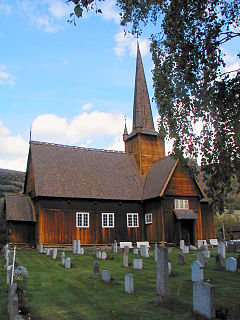
Vågå Church is a historic stave church located in Vågå in Oppland county, Norway.

Fåvang stave church is a parish church located south of the village of Fåvang in Ringebu municipality in Oppland county, Norway. The church is situated in the traditional region of Gudbrandsdal. Fåvang church is an active parish church in the Ringebu parish of the Sør-Gudbrandsdal prosti within the Diocese of Hamar.

Rødven Stave Church is a stave church in Rauma Municipality in Møre og Romsdal county, Norway. It is located in the village of Rødven. The church is part of the Eid og Holm parish in the Indre Romsdal deanery in the Diocese of Møre.

Tingelstad Old Church is a Romanesque stone church located at the village of Tingelstad in Gran, Norway.
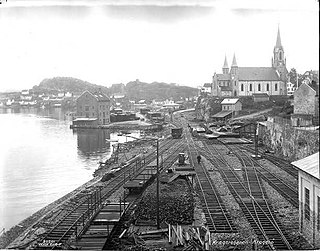
The Kragerø Line was a 27-kilometer (17 mi) long railway line between Neslandsvatn and Kragerø in Telemark, Norway. It was opened on 2 December 1927 as part of the Sørlandet Line. From 10 November 1935, the Sørlandet Line was extended from Neslandsvatn to Arendal, and the Kragerø Line became a branch. It was mostly served with feeder trains, although a through train to Oslo was kept until the 1970s. Falling ridership caused the line to become closed from 1 December 1989, along with many other branch lines. Part of the line remains, although other parts have been demolished.

Skåtøy Church is a church on Skåtøy, an island in the skerries outside the town of Kragerø, Norway. It is also known as the Cathedral of the Skerries.
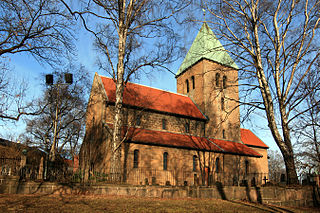
Old Aker Church is a medieval era church located in Oslo, Norway. An active parish, the church is the oldest existing building in Oslo. The church is surrounded by Old Aker Cemetery.
Anna Paulsdatter Krefting née Vogt (1683-1766), was a Norwegian businesswoman who ran and expanded her family's business enterprises in and around Christiania for over 50 years. Among these enterprises were mines and ironworks, forestry, and trade.

Gamlebyen Church is a private church, belonging to Oslo University Hospital and is also called Oslo Hospital's Church, located in the old town of Oslo, Norway. It is leased to the Diocese of Oslo of the Church of Norway and serves as the parish church for the Gamlebyen parish in Oslo. Up to 1925 it had the name Oslo Church, but when the city changed its name from Kristiania to Oslo, the church got the present name. The present church building is listed in 1796 partly on the foundations of the Franciscan monastery church built around 1290. The church is located at the foot of the north-facing slope Ekeberg, across the street from the Gamlebyen Cemetery. The chapel at the cemetery is abandoned as a burial chapel and leased to the Ethiopian community in Oslo. At funerals, the church itself is now used instead.
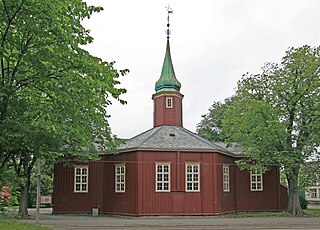
An octagonal church has an octagonal architectural plan. The exterior and the interior may be shaped as eight-sided polygon with approximately equal sides or only the nave is eight-sided supplemented by choir and porch attached to the octagon. This architectural plan is found in some 70 churches in Norway. Among these Hospitalskirken in Trondheim is the oldest. This type of church plan spread from the Diocese of Nidaros to other parts of Norway. Virtually all octagonal churches in Norway are constructed as log buildings mostly covered by clapboards. Some of the largest churches in Norway are octagonal and the list includes important cultural heritage monuments such as Trinity Church (Oslo), Sør-Fron Church and Røros Church.
This is the bright and solemn church room of classicism, whether it is such a large building [as Røros Church] or the modest rural log churches, the interior is covered and interconnected by cheerful colors of the Roccoco in marbling and ceiling. This was our last independent contribution to ecclesiastical architecture.

Grytten Church is a parish church in Rauma Municipality in Møre og Romsdal county, Norway. It is located near the mouth of the Rauma River in the village of Veblungsnes. The church is part of the Grytten parish in the Indre Romsdal deanery in the Diocese of Møre. The red, wooden, octagonal church was built in 1829 possibly using Sør-Fron Church as a model. The church seats about 250 people. Four large columns support the tower. In the church there is a tall wooden crucifix, possibly from the 13th century. The church has so called pulpit altar, that is the pulpit is centrally located directly above the altar. The two churchbells are from the previous churches.
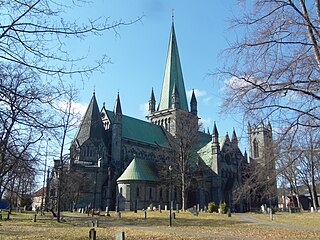
Church building in Norway began when Christianity was established there around the year 1000. The first buildings may have been post churches erected in the 10th or 11th century, but evidence is inconclusive. For instance under Urnes stave church and Lom Stave Church there are traces of older post churches. Post churches were later replaced by the more durable stave churches. About 1,300 churches were built during the 12th and 13th centuries in what was Norway's first building boom. A total of about 3,000 churches have been built in Norway, although nearly half of them have perished. From 1620 systematic records and accounts were kept although sources prior to 1620 are fragmented. Evidence about early and medieval churches is partly archaeological. The "long church" is the most common type of church in Norway. There are about 1620 buildings recognized as churches affiliated with the Church of Norway. In addition there is a number gospel halls belonging to the lay movement affiliated with the Church of Norway as well as churches belonging to other Christian bodies. Until the 20th century most churches were built from wood. 220 buildings are protected by law, and an additional 765 are listed as valuable cultural heritage.
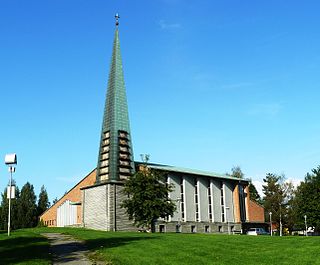
Tonsen Church is a church in Oslo, Norway which was built in 1961. It is located at Årvoll in the borough of Bjerke. The church was constructed by the architects Georg Greve (architect) and Geir Grung.
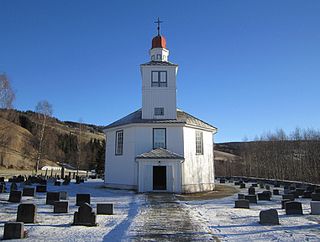
Svatsum Church is an octagonal wooden church dating from 1860 in the municipality of Gausdal in Oppland county, Norway. It is located at the Kirkebøs farm. The church is a timber-framed structure and can accommodate 250 people. It has three bells, dating from c. 1200–1300 and 1981; one of the bells is no longer in use. The altarpiece was painted by Christen Brun. The pulpit dates from 1860, and the pipe organ from 1960. The baptismal bowl is older than the church building. The church was consecrated on October 25, 1860.

